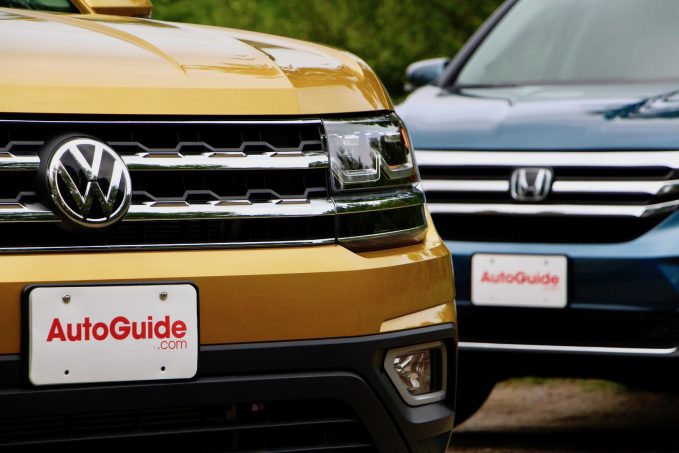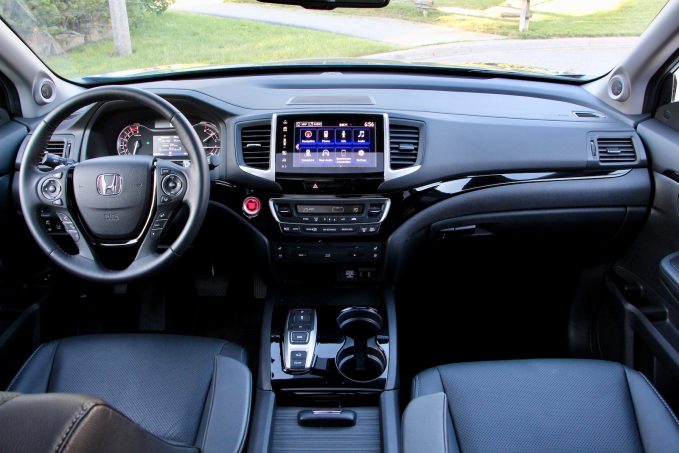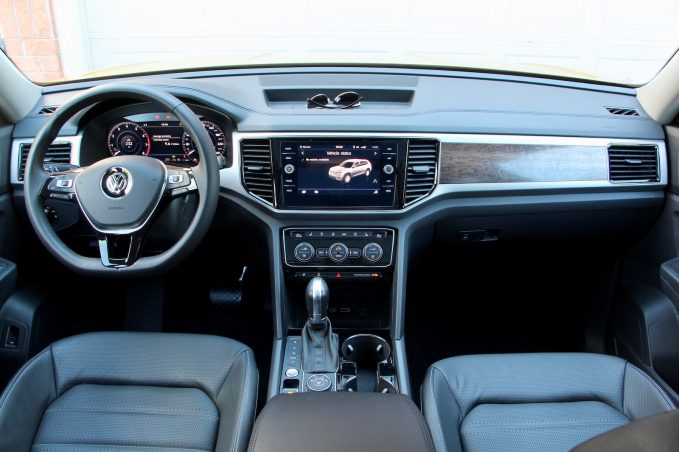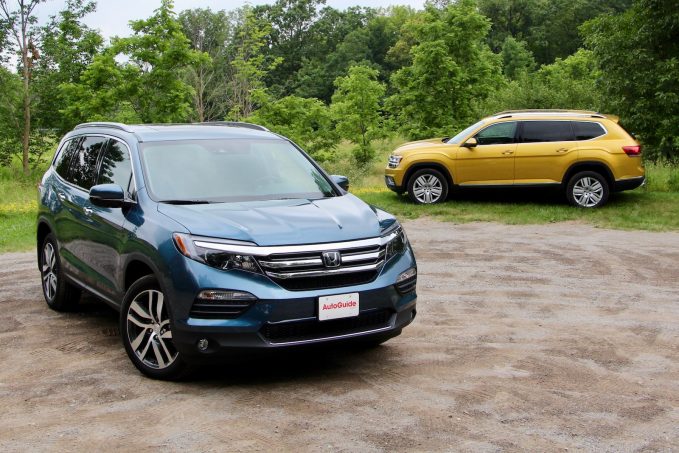For years Volkswagen neglected the SUV segment, with just the undersized Tiguan and overpriced Touareg in their showrooms, but they’re finally bringing a three-row, seven-seat midsize crossover to market with the Atlas.
Is it too little, too late? If they hope to have any success in the segment, the Atlas has to win over customers that have been buying Explorers, Highlanders and Santa Fes for generations, and one of the best of the current crop is the Honda Pilot.
Volkswagen has taken a page out of the Pilot playbook, with a larger footprint placing an emphasis on interior space and cargo capacity, but does it have all the right moves to match up to one of the family favorites in this segment?
Get the Flash Player to see this player.
Cargo
Since these are family cars, we’ll start with what families need most: cargo space and seating. Above all, this is where the Pilot has made a name for itself, with more interior space than seems possible from its midsize footprint, starting with 16 cubic feet (453 L) with all seats in place, 46 (1,303 L) with the third row down, and a maximum of 82 cu-ft (2,324 L) .
The third-row seats and second-row captain’s chairs also fold separately, so you can mix and match your cargo-passenger configurations. The Pilot has convenient underfloor storage, but the cover can easily be dropped to the bottom for a bit of extra space and maximum height.
ALSO SEE: 2018 Volkswagen Atlas Review
Volkswagen engineers clearly wanted to beat the Pilot in the space race, so they went big, and as spacious as the Pilot is, the Atlas outstretches it by 4 inches (about 100 mm) in length and 6 inches (160 mm) in wheelbase. Height and width are about the same, but as you’d expect, the Atlas comes out ahead in cargo and passenger space.
Even with all seats in place, the Atlas is good for over 20 cubic feet (583 L) of cargo space, which means you can schlep around the kids and in-laws and still have plenty of space for the stroller and even a week’s groceries.
Drop the seats and the Atlas stretches its lead even more, with 55 cu-ft (1572 L) behind the second row and 96.8 cu-ft (2,741 L) with all the seats flat, and a bit of extra storage space under the floor where the subwoofer lives. Both vehicles’ seats are easy to fold and raise, so they really live up to the cargo utility part of their mission, but how are humans are treated?
Seating
This Pilot Elite model treats second-row passengers to first-class seating, with wide, comfy captain’s chairs, armrest, center console storage and a roof-mounted entertainment screen.
Even the third row is reasonable for adults, with enough headroom for six-footers, but the seat cushion is pretty low, so taller folk might have their knees up in their face.
The second row of the Atlas might seem flat and uninviting, but the cushion is soft in the right places for decent comfort, and headroom and legroom are excellent.
Although the Atlas is up one seat on the Pilot, that middle position is uncomfortable and best saved for emergency duty.
Child seats and squirming/struggling toddlers are super easy to install in both cars thanks to convenient seat height and wide door openings, and sliding seats allow painless access to the third tether anchor.
ALSO SEE: Midsize Three-Row Crossover Comparison Test
The Pilot is one of those rare cars where the second-row seats might be just as nice as the driver’s seat, but ventilated seats are enough to split the tie in favor of the front row. The leather on the seats and steering wheel is nice, but like the Atlas, the plastics and materials are often hard and unappealing.
Where the Pilot excels is practical cabin amenities, with cupholders, bottle holders, door pockets, phone tray, a big armrest cubby that you could smuggle a watermelon in, enough USB ports to charge the whole family’s array of devices and sunshades for the rear windows. Then again, the Atlas has all that too.
The Pilot’s killer app is a rear-seat entertainment system that can play DVDs or video games, with a detachable remote and wireless headphones so you don’t have to listen to the dulcet tones of Spongebob Squarepants or Pinkie Pie played on an endless loop.
Minivan vs Crossover: 2017 Kia Sedona vs 2017 Hyundai Santa Fe
However, the Atlas tops the Pilot for parent friendliness with seats that flip and slide forward (even with child seats installed) to allow wide access to the third row, which is a bit tighter for headroom, but offers more legroom and more comfortable seats that aren’t so close to the floor. Overall, with more space and a few thoughtful touches, the Atlas comes out ahead on the utility front.
The front seats add a bit of sportiness with side bolsters to keep you in place, but they’re not intrusive enough to bother me, and the seats themselves are pleasing, so here they’ve found a more successful middle ground. And they’re heated and cooled for all-season comfort.
The rest of the cockpit is basic, straightforward and holds no surprises. The plastics are a bit chintzy, the fake stitching is tacky and the woodgrain pattern on the dash is a bit sad for a $50,000 car, so it doesn’t hold a candle to segment leaders like the CX-9, but it’s at least as good as the Pilot.
Power and Efficiency
Considering both cars feature similarly sized V6 engines, transmissions with a bunch of gears and about the same power, it’s amazing how differently they drive.
The 4,500-pound Atlas is powered by Volkswagen’s 3.6-liter V6, which makes 276 horsepower and 266 lb-ft of torque. While that is less power than the Pilot, it’s more torque and that torque arrives a couple thousand rpm sooner. Not only is peak torque online earlier, throttle response is sharp – perhaps a little too sharp, as the Atlas tends to jerk away from a stop if you don’t carefully roll on the gas.
The Atlas has a few driving modes for greater efficiency or sportiness, and one that can mix and match settings for steering, transmission and engine response.
With direct injection and eight speeds in its transmission, Volkswagen engineers have squeezed out 17 mpg in the city, 23 on the highway and 19 mpg combined (13.7/10.1/12.1 L/100 km), which is what we’ve seen after a couple weeks of mixed use.
Compare Specs
The Honda Pilot is almost a couple hundred pounds lighter than the Atlas, so in theory, its 280-hp 3.5-liter V6 should be sufficient to get it going, so why does it feel so goddamn slow?
I’d be perfectly happy blaming the 262 lb-ft of torque, which only arrives at 4,700 rpm, but initial throttle response is painfully slow. While it is slow, it’s definitely smooth off the line and right up to highway speeds, and the transmission never missed a beat.
The Pilot has a simple Econ button for added efficiency and a Sport setting for the transmission, but even with Econ off and Sport mode on, engine response is frustratingly unhurried when getting going, although it is quick enough to gear down for passing maneuvers on the highway.
The Pilot’s V6 also features direct injection and variable timing and tops the Atlas with nine forward gears in its transmission for superior efficiency, officially 19 mpg in the city, 26 on the highway and 22 combined (12.4/9.3/11.0 L/100 km). Although we haven’t quite matched that, we are close, with the trip computer currently showing over 21 mpg (11.2 L/100 km) for the past couple weeks, with a little more highway mileage in the mix than the Atlas saw.
The biggest Volkswagen we’ve ever seen drives just like that: big. The windows are tall and visibility is good, but the square flat hood can be intimidating to navigate through tight city streets and parking lots. However, that square hood and blunt face make it easy to tell exactly where the corners of the car are, the VW actually has a tighter turning circle than the Pilot, and 360-degree parking cameras take the stress out of parking (and rear cross-traffic alert help take the stress out of exiting your parking spot).
Volkswagen had years to benchmark the Pilot and others in the segment, so if there’s one thing that surprised me it was the ride quality. Frankly, it’s too rough. Almost every bump sends a shiver through the chassis and big lumps rock the cabin with a clank of protest from the suspension.
Sure, it means that the Atlas turns in sharply and holds steady in the corners, but this is no GTI, and it’s not worth the constant jiggling and jarring on rough city streets and every dip or manhole cover.
ALSO SEE: Ford Explorer vs Honda Pilot
The Pilot may not be thrilling to drive, but it’s just about perfect for this class. Considering this segment has become little more than a minivan substitute (which is why we aren’t planning to go off-road with them), comfort needs to be the prime directive for these shuttles, and here the Pilot shines.
Smaller bumps are almost entirely dismissed without feeling a thing, and larger bumps and dips result in a brief jiggle that is quickly absorbed and you’re on your way. Of course, there is a fair bit more body roll in turns, but the steering is steady and the Pilot feels composed even when pushed through corners.
On the highway, there’s little to report, with a bit of wind and tire noise, but not enough to draw complaints, though I’d say it is a touch quieter than the Atlas.
On paper, the Pilot has a wider turning circle, but its sloping hood and rounded corners make it feel less cumbersome in tight quarters, and because it’s shorter it can be easier to navigate tricky parking maneuvers.
However, with only a rearview camera and a goofy push-button transmission, it loses points to the Atlas in total ease of parking.
Technology
We could probably spend pages and page going on about driving aids and automatic safety systems, but I won’t bore you with that because they both seem to have them all.
I will point out that the Atlas’s adaptive cruise works all the way down to crawling speeds and brief stops while the Pilot cuts out at lower speeds. The Pilot also tends to flash forward collision warnings a little too eagerly – it seems like it’s constantly going off in rush-hour traffic.
ALSO SEE: 2018 Volkswagen Atlas Pricing Released for 5 Trim Levels
Both of these cars offer Apple CarPlay and Android Auto compatibility, but Volkswagen’s mixture of touchscreen and hard buttons make its built-in infotainment system easier to use than the Pilot’s pure touchscreen system, and VW’s new digital gauge cluster is loaded with information and looks nice.
All the buttons and controls are conventional, clearly labeled and it has a volume knob, so that’s an automatic win for ergonomics in the Atlas. Plus, the sound quality with the upgraded Fender audio system is a fair bit better than the Pilot’s.
Value and Verdict: Volkswagen Atlas vs Honda Pilot Comparison Test
The Volkswagen comes in at a slightly lower starting price, but both start at a bit more than $31K, although the V6 is standard in the Pilot while the base Atlas is powere
d by VW’s 2.0T with 235 hp and 258 lb-ft of torque.
At the top of the lineups, the Pilot Elite maxes out at $48,160 ($940 freight included), and the Atlas SEL Premium is only another thousand at $49,415 ($925 freight included). In Canada, the gap is about the same, a top-trim Pilot Touring running $53,215 ($1,725 freight included) compared to the Atlas Execline at $54,335 ($1,795 freight included). However, the Atlas is missing that rear entertainment system that can help soothe stir-crazy kids on long road trips. Or short ones. No judging here.
Well, we are judging these vehicles, so let’s recap the highs lows of each one. The Volkswagen impressed with tons of cargo and passenger space, sporty acceleration and handling made it a bit more fun, and who doesn’t love 360-degree parking cameras? The Pilot’s comfortable ride was dreamy, and powertrain was smooth and efficient, and it too offers plenty of cargo space and spacious cabin.
I could probably live with the jerky, lurching acceleration and lackluster interior quality of the Atlas, but the hard ride is its biggest misstep. Similarly, the adaptive cruise and the slow, clunky infotainment would annoy me, but the Pilot’s delayed acceleration would be incredibly frustrating to live with.
The Volkswagen finally has a seven-seat people mover they can be proud to put their badge on, and it’s a capable and practical crossover that does most things right, with plenty of thoughtful touches, but the rough ride and overeager acceleration are cardinal sins for me.
The Honda Pilot’s slow throttle response and infotainment system are easier to forgive when weighed against everything that it does so well.
With plenty of cargo space in its own right and room for the whole family, the Honda Pilot drives away with the win thanks to a comfortable ride, impressive efficiency and being so easy to live with.












